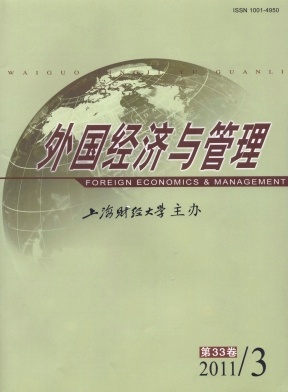国外员工主动行为研究新进展探析
外国经济与管理 2011 年 第 33 卷第 03 期, 页码:58 - 65
摘要
参考文献
摘要
随着组织任务需求的不断变化以及环境不确定性的提高,员工仅仅被动接受和完成组织规定的工作任务已经远远不够,员工的主动行为对于组织的成功日益重要。本文从主动行为研究产生的背景出发,介绍了员工主动行为的概念内涵、前因变量及其作用机制,以及影响结果,并在此基础上,对未来的研究方向进行了展望。
[1]Fay,D,and Frese,M.The concept of personal initiative:An overview of validity studies[J].Human Performance,2001,14(1):97-124.
[2]Griffin,M A,Neal,A,and Parker,S K.A new model of work role performance:Positive behavior in uncertain and interde-pendent contexts[J].Academy of Management Journal,2007,50(2):327-347.
[3]Locke,E A,and Latham,G P.Building a practically useful theory of goal setting and task motivation:A 35-year odyssey[J].American Psychologist,2002,57(9):705-717.
[4]Ashforth,B E,Sluss,D M,and Saks,A M.Socialization tactics,proactive behavior,and newcomer learning:Integrating so-cialization models[J].Journal of Vocational Behavior,2007,70(3):447-462.
[5]Brotheridge,C M,and Grandey,A A.Emotional labor and burnout:Comparing two perspectives of people work[J].Journal ofVocational Behavior,2002,60(1):17-39.
[6]Morrison,E W.Newcomers’relationships:The role of social network ties during socialization[J].Academy of ManagementJournal,2002,45(6):1 149-1 160.
[7]Grant,A M,and Ashford,S J.The dynamics of proactively at work:Lessons from feedback-seeking and organizational citizen-ship behavior research[A].in B M Staw,and R M Sutton(Eds.).Research in organizational behavior[C].Amsterdam:Elsevier Sci-ence,2008,28:3-34.
[8]Parker,S K,and Collins,C G.Taking stock:Integrating and differentiating multiple proactive behaviors[J].Journal ofManagement,2010,36(3):633-662.
[9]Roberts,B W,Chernyshenko,O,Stark,S,and Goldberg,L.The structure of conscientiousness:An empirical investigationbased on seven major personality questionnaires[J].Personnel Psychology,2005,58(1):103-139.
[10]Klein,K J,Lim,B C,Saltz,J L,and Mayer,D M.How do they get there?An examination of the antecedents of centralityin team networks[J].Academy of Management Journal,2004,47(6):952-963.
[11]Tamir,M.Don’t worry,be happy?Neuroticism,trait-consistent affect regulation and performance[J].Journal of Personalityand Social Psychology,2005,89(3):449-461.
[12]Strauss,K,Griffin,M A,and Parker,S K.Future work selves:How hoped for and feared selves motivate behavior in organi-zations[R].Working Paper,Institute of Work Psychology,University of Sheffield,Sheffield,UK,2009.
[13]Fritz,C,and Sonnentag,S.Antecedents of day-level proactive behavior:A look at job stressors and positive affect during theworkday[J].Journal of Management,2009,35(1):94-111.
[14]Morgeson,F P,and Humphrey,S E.The Work Design Questionnaire(WDQ):Developing and validating a comprehensivemeasure for assessing job design and the nature of work[J].Journal of Applied Psychology,2006,91(6):1 321-1 339.
[15]Rank,J,Nelson,N E,Allen,T D,and Xu,X.Leadership predictors of innovation and task performance:Subordinates’self-esteem and self-presentation as moderators[J].Journal of Occupational and Organizational Psychology,2009,82(3):465-489.
[16]Frese,M,Garst,H,and Fay,D.Making things happen:Reciprocal relationships between work characteristics and personalinitiative in a four-wave longitudinal structural equation model[J].Journal of Applied Psychology,2007,92(4):1 084-1 102.
[17]Deluga,R J.American presidential proactively,charismatic leadership,and rated performance[J].Leadership Quarterly,1998,9(3):265-291.
[18]Chan,D.Interactive effects of situational judgment effectiveness and proactive personality on work perceptions and work out-comes[J].Journal of Applied Psychology,2006,91(2):475-481.
[19]Grant,A M,Parker,S K,and Collins,C G.Getting credit for proactive behavior:Supervisor reactions depend on what youvalue and how you feel[J].Personnel Psychology,2009,62(1):31-55.
[2]Griffin,M A,Neal,A,and Parker,S K.A new model of work role performance:Positive behavior in uncertain and interde-pendent contexts[J].Academy of Management Journal,2007,50(2):327-347.
[3]Locke,E A,and Latham,G P.Building a practically useful theory of goal setting and task motivation:A 35-year odyssey[J].American Psychologist,2002,57(9):705-717.
[4]Ashforth,B E,Sluss,D M,and Saks,A M.Socialization tactics,proactive behavior,and newcomer learning:Integrating so-cialization models[J].Journal of Vocational Behavior,2007,70(3):447-462.
[5]Brotheridge,C M,and Grandey,A A.Emotional labor and burnout:Comparing two perspectives of people work[J].Journal ofVocational Behavior,2002,60(1):17-39.
[6]Morrison,E W.Newcomers’relationships:The role of social network ties during socialization[J].Academy of ManagementJournal,2002,45(6):1 149-1 160.
[7]Grant,A M,and Ashford,S J.The dynamics of proactively at work:Lessons from feedback-seeking and organizational citizen-ship behavior research[A].in B M Staw,and R M Sutton(Eds.).Research in organizational behavior[C].Amsterdam:Elsevier Sci-ence,2008,28:3-34.
[8]Parker,S K,and Collins,C G.Taking stock:Integrating and differentiating multiple proactive behaviors[J].Journal ofManagement,2010,36(3):633-662.
[9]Roberts,B W,Chernyshenko,O,Stark,S,and Goldberg,L.The structure of conscientiousness:An empirical investigationbased on seven major personality questionnaires[J].Personnel Psychology,2005,58(1):103-139.
[10]Klein,K J,Lim,B C,Saltz,J L,and Mayer,D M.How do they get there?An examination of the antecedents of centralityin team networks[J].Academy of Management Journal,2004,47(6):952-963.
[11]Tamir,M.Don’t worry,be happy?Neuroticism,trait-consistent affect regulation and performance[J].Journal of Personalityand Social Psychology,2005,89(3):449-461.
[12]Strauss,K,Griffin,M A,and Parker,S K.Future work selves:How hoped for and feared selves motivate behavior in organi-zations[R].Working Paper,Institute of Work Psychology,University of Sheffield,Sheffield,UK,2009.
[13]Fritz,C,and Sonnentag,S.Antecedents of day-level proactive behavior:A look at job stressors and positive affect during theworkday[J].Journal of Management,2009,35(1):94-111.
[14]Morgeson,F P,and Humphrey,S E.The Work Design Questionnaire(WDQ):Developing and validating a comprehensivemeasure for assessing job design and the nature of work[J].Journal of Applied Psychology,2006,91(6):1 321-1 339.
[15]Rank,J,Nelson,N E,Allen,T D,and Xu,X.Leadership predictors of innovation and task performance:Subordinates’self-esteem and self-presentation as moderators[J].Journal of Occupational and Organizational Psychology,2009,82(3):465-489.
[16]Frese,M,Garst,H,and Fay,D.Making things happen:Reciprocal relationships between work characteristics and personalinitiative in a four-wave longitudinal structural equation model[J].Journal of Applied Psychology,2007,92(4):1 084-1 102.
[17]Deluga,R J.American presidential proactively,charismatic leadership,and rated performance[J].Leadership Quarterly,1998,9(3):265-291.
[18]Chan,D.Interactive effects of situational judgment effectiveness and proactive personality on work perceptions and work out-comes[J].Journal of Applied Psychology,2006,91(2):475-481.
[19]Grant,A M,Parker,S K,and Collins,C G.Getting credit for proactive behavior:Supervisor reactions depend on what youvalue and how you feel[J].Personnel Psychology,2009,62(1):31-55.
引用本文
张桂平, 廖建桥. 国外员工主动行为研究新进展探析[J]. 外国经济与管理, 2011, 33(3): 58–65.
导出参考文献,格式为:





 8891
8891  397
397

